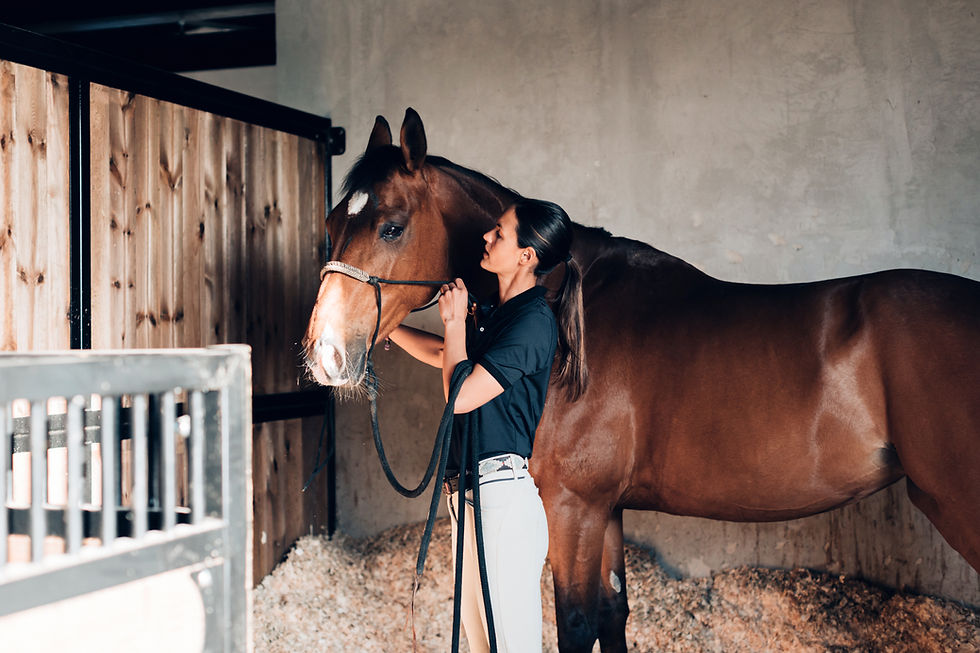The Missing Link in Equine Therapy? You
- IRVAP
- Oct 1
- 4 min read

YHC's HOT TOPIC
The Missing Link in Equine Therapy? You

When it comes to optimising your horse’s health and performance, the role of professional support is invaluable. Physiotherapists, hydrotherapists, and veterinarians all bring their expertise to identify, treat, and monitor musculoskeletal issues. But there’s a crucial piece of the puzzle that often gets overlooked: your role as the horse’s owner or rider.
Learning to assess your own horse—regularly and with intention—not only helps you measure performance but also makes your therapist’s job more accurate and effective. After all, you are the one who sees your horse every day. Subtle changes in movement, behaviour, or performance can easily slip by if you don’t have a structured way of noticing them.
Why owner assessment matters
Horses are masters of compensation. They may develop small movement restrictions or imbalances and quietly adjust their way of going without showing an obvious lameness. A therapist might only see your horse once every four to six weeks, but you have the unique advantage of daily contact. That makes you the eyes and ears between sessions.
By assessing your horse’s posture, way of moving, and general demeanour, you create a baseline. With consistent checks, you can identify when something changes—perhaps the stride feels shorter on one rein, the transitions become sticky, or your horse resists grooming in a certain spot. These observations, when communicated clearly, provide your therapist with valuable data to tailor their assessment and treatment.
Supporting performance measurement
Performance isn’t just about winning rosettes; it’s about your horse being comfortable, efficient, and confident in their work. Small issues can chip away at this over time. Owner assessments allow you to track:
Stride length and rhythm – Is the trot fluid and consistent, or does it feel uneven?
Straightness – Does the horse drift through the shoulder or quarters?
Flexion and bend – Is one rein consistently more difficult?
Attitude to work – Is your horse keen and forward, or do they feel reluctant and resistant?
Recovery – How quickly does your horse catch their breath after exertion?
These are all subtle markers of performance. If you’re attentive to them, you can catch small declines before they snowball into bigger issues. For competitive riders, it also means you can monitor how well your training programme is supporting performance and comfort.

Helping your therapist
When a therapist comes to reassess your horse, their goal is to measure progress against the last session. But without your feedback, they’re working with only a snapshot in time. Imagine if you could share a record of the following:
When you first noticed stiffness or unevenness.
Whether the horse felt better or worse after particular types of exercise.
Any patterns in behaviour—such as reluctance to pick up a lead, spooking more than usual, or difficulty maintaining canter.
How long improvements lasted after the previous session.
This kind of information is like gold to a therapist. It helps them see the bigger picture, adapt their treatment plan, and advise you more precisely on management, exercise, and follow-up care.
How to assess your horse at home
The good news is that you don’t need specialist equipment or training to begin assessing your horse. Start with simple, consistent observations:
Daily check-in – Notice how your horse greets you. Are they bright, relaxed, or a little withdrawn?
Palpation – Run your hands over your horse’s body, feeling for heat, tension, or reactivity.
Movement on the ground – Walk and trot your horse in hand. Watch from the front, side, and behind. Look for straightness and rhythm.
Under saddle feel – Pay attention to transitions, bend, impulsion, and willingness.
Record your findings – Keep a simple logbook or use a phone app. Even quick notes like “felt stiff left rein today” or “canter transitions smooth” can be powerful over time.
Consistency is key. The more often you assess, the easier it becomes to pick up patterns.
The partnership approach
Working with your therapist should feel like a team effort. They bring the clinical knowledge, while you bring daily insights. When these two perspectives combine, your horse benefits from more precise care and improved performance.
Think of it as a triangle: you, your horse, and your therapist. Each corner of the triangle plays an essential role. Without owner input, the therapist may miss crucial context. Without professional assessment, the owner may overlook subtle clinical signs. Together, the triangle becomes strong, balanced, and effective.

Long-term benefits
Owners who take the time to assess their horses regularly often find that:
Problems are caught earlier, reducing the risk of injury.
Horses stay more comfortable and willing in their work.
Training progress is smoother because small setbacks are managed quickly.
Therapy sessions are more productive and tailored.
They develop a deeper understanding and bond with their horse.
In other words, the benefits go far beyond just supporting your therapist—they ripple out into every aspect of your horse’s wellbeing and performance.
Final thoughts
Assessing your own horse isn’t about replacing professional expertise. It’s about being an active participant in your horse’s care. By noticing, recording, and communicating changes, you give your therapist the tools they need to deliver the best possible treatment.
Performance measurement isn’t only about the stopwatch or the scoreboard; it starts with everyday observation. With your involvement, therapy becomes more targeted, performance is easier to track, and your horse’s comfort and wellbeing are prioritised.
So next time you tack up, take a few minutes to really notice how your horse feels and moves. It may be the most important habit you ever develop for their long-term health and performance.




